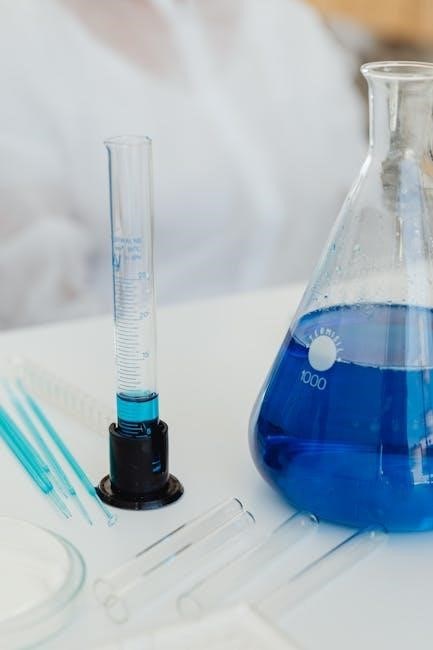Physical changes involve alterations in state or properties without forming new substances, while chemical changes create new substances through reactions. Understanding these concepts aids in solving worksheet problems effectively.
1.1 Definition of Physical Changes
A physical change occurs when a substance alters its state or properties without forming a new substance. Examples include ice melting, water evaporating, or salt dissolving. These changes are often reversible and do not involve chemical reactions. Identifying such changes is crucial for accurately answering worksheet questions on physical and chemical changes.
1.2 Definition of Chemical Changes
A chemical change involves the transformation of one substance into another, forming new products with different properties. It occurs through chemical reactions, often irreversible, and is accompanied by changes like color, odor, or release of energy. Examples include rusting of iron or burning of wood, where new substances are created, distinguishing it from physical changes.

Key Characteristics of Physical and Chemical Changes
Physical changes involve state alterations without new substances, while chemical changes create new substances through reactions. Physical changes are reversible, whereas chemical changes are often irreversible.
2.1 Physical Changes: Observations and Examples
Physical changes involve alterations in state or properties without forming new substances. Common examples include ice melting, water evaporating, and salt dissolving in water. These changes are often reversible, such as freezing water into ice or condensing vapor back into liquid. Observing these changes helps distinguish them from chemical changes, which involve the creation of new substances through reactions.
2.2 Chemical Changes: Observations and Examples
Chemical changes result in the formation of new substances and are often irreversible. Examples include rust forming on iron, wood burning into ash, and butter turning rancid. These changes are typically accompanied by indicators like color variation, odor, or gas release. Unlike physical changes, chemical changes alter the composition of matter, making them more complex to reverse or undo naturally.

Identifying Physical and Chemical Changes in Worksheets
Identifying changes involves analyzing processes and their outcomes. Physical changes, like salt dissolving, don’t alter substances, while chemical changes, such as butter degrading, create new substances.
3.1 Labeling Processes as Physical or Chemical
Labeling processes involves determining if a change alters the substance’s identity. Physical changes, like perfume evaporating, don’t create new substances. Chemical changes, such as butter degrading, do. Examples include salt dissolving (physical) and rust forming (chemical). Understanding these distinctions is key to accurately categorizing processes in worksheets. Always look for signs like new substances or irreversible alterations to determine the type of change.
3.2 Common Examples from Worksheets
Worksheets often include examples like salt dissolving in water (physical) and rust forming (chemical). Physical changes, such as ice melting, involve state changes without new substances. Chemical changes, like wood burning, produce new materials. Recognizing these examples helps students classify processes accurately, ensuring a solid grasp of the concepts for problem-solving and assessment purposes.
Properties of Matter and Changes
Physical properties, like color and melting point, are observed without altering the substance. Chemical properties, such as flammability, involve changes that transform the substance entirely.
4.1 Physical Properties: Definition and Examples
Physical properties are characteristics of matter that can be observed or measured without changing its identity. Examples include color, odor, state (solid, liquid, gas), and solubility. These properties help identify substances and understand physical changes, such as melting or evaporation, which occur without forming new substances. Recognizing physical properties aids in solving worksheet questions about physical changes.

4.2 Chemical Properties: Definition and Examples
Chemical properties describe characteristics of matter that can only be observed during a chemical reaction. Examples include flammability, reactivity with acids, and the ability to rust. These properties are identified when a substance undergoes a chemical change, forming new substances. Understanding chemical properties helps in distinguishing between physical and chemical changes, aiding in solving worksheet questions about chemical reactions and their outcomes.
Reversible and Irreversible Changes
Reversible changes, like water freezing, can return to their original state, while irreversible changes, such as rust forming, cannot be easily undone. Examples clarify these concepts for worksheets.
5.1 Physical Changes: Reversibility
Physical changes are often reversible, meaning the original substance can be restored. For example, ice melting into water is reversible when refrozen. Similarly, evaporated water can condense back into liquid. These changes do not alter the chemical identity of the substance, making them temporary and reversible under specific conditions. Understanding reversibility aids in identifying physical changes in worksheets and real-world scenarios effectively.
5.2 Chemical Changes: Irreversibility
Chemical changes are typically irreversible, as they involve the formation of new substances. For instance, rust forming on iron or food cooking cannot easily be reversed. These changes alter the chemical composition, creating substances with different properties. Unlike physical changes, reversing chemical changes often requires complex processes, making them permanent under normal conditions. This understanding is crucial for identifying and analyzing chemical changes in worksheets and real-world applications.

Practical Applications of Physical and Chemical Changes
Physical changes, like water evaporation, and chemical changes, such as food cooking, are everyday occurrences with practical uses in industries and households, shaping our daily lives.
6.1 Everyday Examples of Physical Changes
Physical changes occur around us daily, such as ice melting into water, water evaporating into vapor, and salt dissolving in water. These changes involve no new substance formation but alter state or appearance, making them reversible and integral to natural processes and household activities.
6.2 Everyday Examples of Chemical Changes
Chemical changes are evident in daily life, such as food cooking, iron rusting, and wood burning. These processes result in new substances, altering the chemical makeup, and are often irreversible. Understanding these examples helps in identifying chemical changes in worksheet questions and real-world applications.

Solving Worksheets on Physical and Chemical Changes
Mastering worksheet questions involves analyzing changes, identifying key characteristics, and using answer keys for verification. Practice and understanding concepts ensure accuracy and confidence in problem-solving.
7.1 Tips for Answering Worksheet Questions
To excel in worksheet questions, carefully read each scenario and identify key characteristics of changes. Use answer keys to verify solutions and improve understanding. Practice regularly to recognize patterns and apply concepts effectively. Focus on distinguishing physical changes, which involve state alterations, from chemical changes, which produce new substances. Understanding reversibility and properties enhances accuracy in problem-solving.
7.2 Common Mistakes to Avoid
Common mistakes include confusing physical and chemical changes, such as misclassifying state changes as chemical. Students often overlook the formation of new substances in chemical changes. Reversible processes are sometimes assumed to be physical without verification. Additionally, misidentifying properties, like color or odor changes, as physical traits can lead to errors. Regular practice and reviewing answer keys help minimize these mistakes.
Answer Keys and Resources
Answer keys provide accurate solutions to worksheet questions, helping students verify their work and understand mistakes. Accessing PDF worksheets and solutions ensures comprehensive learning and quick reference for complex problems.
8.1 Importance of Answer Keys for Learning
Answer keys are essential for verifying solutions and understanding mistakes. They provide clarity on complex concepts, ensuring students grasp physical and chemical changes accurately. By referencing answer keys, learners can identify errors, improve problem-solving skills, and gain confidence in their abilities. These resources are vital for self-assessment and effective study habits, fostering a deeper understanding of the subject matter efficiently.
8.2 Accessing PDF Worksheets and Solutions
Premium resources, including PDF worksheets and solutions, are readily available online. Educational websites and platforms offer downloadable materials, providing structured exercises and detailed answers. These PDFs are ideal for self-study, ensuring access to comprehensive learning tools. Students can easily find and download these resources, enhancing their understanding of physical and chemical changes with clear examples and solutions.

Teaching Tools and Resources
Interactive worksheets, video tutorials, and PDF solutions are essential teaching tools. These resources provide structured learning, making complex concepts like physical and chemical changes more accessible.
9.1 Interactive Worksheets for Better Understanding
Interactive worksheets are dynamic tools that engage students, offering hands-on practice. They include drag-and-drop activities, quizzes, and real-time feedback. These features make learning physical and chemical changes more engaging, allowing students to visualize concepts and apply knowledge effectively. Accessible in PDF formats, these worksheets cater to various learning styles, enhancing comprehension and retention of key chemistry concepts.
9.2 Videos and Tutorials for Visual Learning
Videos and tutorials provide visual explanations, making complex concepts like physical and chemical changes accessible. Demonstrations of experiments and real-world examples help students grasp processes like evaporation or combustion. These resources, often paired with worksheet answers, offer a comprehensive learning experience, reinforcing theoretical knowledge with practical visuals.

Mastering the Concept of Changes
Mastering physical and chemical changes requires consistent practice, understanding properties of matter, and applying concepts to real-world scenarios for a deeper grasp of the subject.
10.1 Key Strategies for Success
Key strategies for understanding physical and chemical changes include regular practice with worksheets, analyzing examples, and reviewing answer keys. Consistent revision helps reinforce concepts, while interactive tools and video tutorials provide visual learning opportunities. Focusing on problem-solving techniques and avoiding common mistakes ensures a solid grasp of the subject, making it easier to tackle complex questions confidently.
10.2 Practice Exercises and Quizzes
Regular practice with worksheets and quizzes is essential for mastering physical and chemical changes. Interactive tools and PDF resources provide hands-on experience, while answer keys offer immediate feedback. Quizzes help identify weak areas, ensuring thorough understanding. Consistent practice builds confidence, enabling students to approach complex problems with ease and accuracy, while preparing them for exams and real-world applications.
Real-World Applications
Physical and chemical changes are evident in everyday processes like cooking, rust formation, and perfume evaporation. These concepts are crucial in industries such as manufacturing and medicine.
11.1 Industrial Applications of Physical Changes
Physical changes are fundamental in various industrial processes. For instance, the refining of crude oil involves fractional distillation, a physical process that separates components based on boiling points. Additionally, manufacturing industries use physical changes like melting and solidification to produce metals and plastics. These processes are essential for creating materials used in construction, electronics, and packaging, highlighting their economic and practical importance globally.
11.2 Industrial Applications of Chemical Changes
Chemical changes are pivotal in industrial processes, driving innovation and production. For example, the manufacturing of steel involves chemical reactions like smelting, where iron ore reacts with carbon to produce pure iron. Similarly, the production of fertilizers relies on chemical synthesis to create compounds like ammonia. These transformations are essential for advancing technology, agriculture, and pharmaceuticals, showcasing the vast utility of chemical changes in modern industries.
Understanding physical and chemical changes is crucial for mastering chemistry. Worksheets provide practical insights, helping students differentiate between changes and apply concepts to real-world scenarios effectively.

12.1 Summary of Key Concepts

Physical changes involve state alterations without new substances, while chemical changes produce new substances. Worksheets help identify these changes, emphasizing reversibility and irreversibility. Key concepts include recognizing properties, classifying changes, and understanding practical applications in everyday and industrial contexts. Mastery requires practice, avoiding common mistakes, and utilizing resources like answer keys and PDF guides for clarity and improvement in learning chemistry fundamentals.
12.2 Encouragement for Further Study
Exploring physical and chemical changes beyond worksheets enhances scientific literacy. Delve into real-world applications, engage with interactive tools, and solve diverse problems to deepen understanding. Encourage curiosity by pursuing additional resources like videos and tutorials. Continuous practice and exploration foster a strong foundation in chemistry, preparing for advanced studies and practical applications in various fields.




































